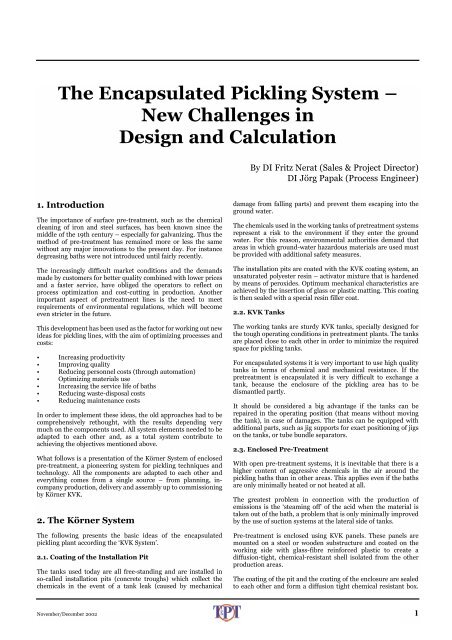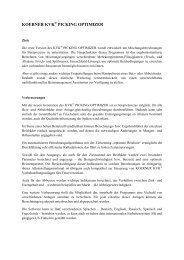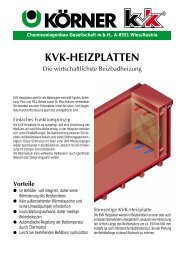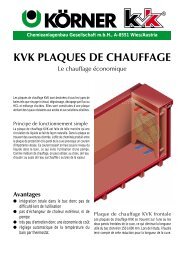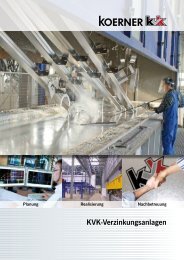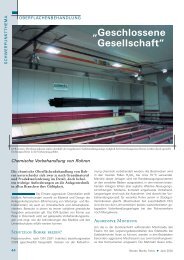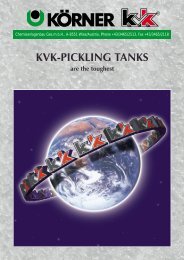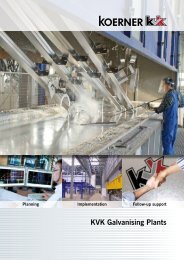The Encapsulated Pickling System – New Challenges in ... - Koerner
The Encapsulated Pickling System – New Challenges in ... - Koerner
The Encapsulated Pickling System – New Challenges in ... - Koerner
Create successful ePaper yourself
Turn your PDF publications into a flip-book with our unique Google optimized e-Paper software.
<strong>The</strong> <strong>Encapsulated</strong> <strong>Pickl<strong>in</strong>g</strong> <strong>System</strong> <strong>–</strong><br />
<strong>New</strong> <strong>Challenges</strong> <strong>in</strong><br />
Design and Calculation<br />
1. Introduction<br />
<strong>The</strong> importance of surface pre-treatment, such as the chemical<br />
clean<strong>in</strong>g of iron and steel surfaces, has been known s<strong>in</strong>ce the<br />
middle of the 19th century <strong>–</strong> especially for galvaniz<strong>in</strong>g. Thus the<br />
method of pre-treatment has rema<strong>in</strong>ed more or less the same<br />
without any major <strong>in</strong>novations to the present day. For <strong>in</strong>stance<br />
degreas<strong>in</strong>g baths were not <strong>in</strong>troduced until fairly recently.<br />
<strong>The</strong> <strong>in</strong>creas<strong>in</strong>gly difficult market conditions and the demands<br />
made by customers for better quality comb<strong>in</strong>ed with lower prices<br />
and a faster service, have obliged the operators to reflect on<br />
process optimization and cost-cutt<strong>in</strong>g <strong>in</strong> production. Another<br />
important aspect of pretreatment l<strong>in</strong>es is the need to meet<br />
requirements of environmental regulations, which will become<br />
even stricter <strong>in</strong> the future.<br />
This development has been used as the factor for work<strong>in</strong>g out new<br />
ideas for pickl<strong>in</strong>g l<strong>in</strong>es, with the aim of optimiz<strong>in</strong>g processes and<br />
costs:<br />
• Increas<strong>in</strong>g productivity<br />
• Improv<strong>in</strong>g quality<br />
• Reduc<strong>in</strong>g personnel costs (through automation)<br />
• Optimiz<strong>in</strong>g materials use<br />
• Increas<strong>in</strong>g the service life of baths<br />
• Reduc<strong>in</strong>g waste-disposal costs<br />
• Reduc<strong>in</strong>g ma<strong>in</strong>tenance costs<br />
In order to implement these ideas, the old approaches had to be<br />
comprehensively rethought, with the results depend<strong>in</strong>g very<br />
much on the components used. All system elements needed to be<br />
adapted to each other and, as a total system contribute to<br />
achiev<strong>in</strong>g the objectives mentioned above.<br />
What follows is a presentation of the Körner <strong>System</strong> of enclosed<br />
pre-treatment, a pioneer<strong>in</strong>g system for pickl<strong>in</strong>g techniques and<br />
technology. All the components are adapted to each other and<br />
everyth<strong>in</strong>g comes from a s<strong>in</strong>gle source <strong>–</strong> from plann<strong>in</strong>g, <strong>in</strong>company<br />
production, delivery and assembly up to commission<strong>in</strong>g<br />
by Körner KVK.<br />
2. <strong>The</strong> Körner <strong>System</strong><br />
<strong>The</strong> follow<strong>in</strong>g presents the basic ideas of the encapsulated<br />
pickl<strong>in</strong>g plant accord<strong>in</strong>g the ‘KVK <strong>System</strong>’.<br />
2.1. Coat<strong>in</strong>g of the Installation Pit<br />
<strong>The</strong> tanks used today are all free-stand<strong>in</strong>g and are <strong>in</strong>stalled <strong>in</strong><br />
so-called <strong>in</strong>stallation pits (concrete troughs) which collect the<br />
chemicals <strong>in</strong> the event of a tank leak (caused by mechanical<br />
November/December 2002<br />
By DI Fritz Nerat (Sales & Project Director)<br />
DI Jörg Papak (Process Eng<strong>in</strong>eer)<br />
damage from fall<strong>in</strong>g parts) and prevent them escap<strong>in</strong>g <strong>in</strong>to the<br />
ground water.<br />
<strong>The</strong> chemicals used <strong>in</strong> the work<strong>in</strong>g tanks of pretreatment systems<br />
represent a risk to the environment if they enter the ground<br />
water. For this reason, environmental authorities demand that<br />
areas <strong>in</strong> which ground-water hazardous materials are used must<br />
be provided with additional safety measures.<br />
<strong>The</strong> <strong>in</strong>stallation pits are coated with the KVK coat<strong>in</strong>g system, an<br />
unsaturated polyester res<strong>in</strong> <strong>–</strong> activator mixture that is hardened<br />
by means of peroxides. Optimum mechanical characteristics are<br />
achieved by the <strong>in</strong>sertion of glass or plastic matt<strong>in</strong>g. This coat<strong>in</strong>g<br />
is then sealed with a special res<strong>in</strong> filler coat.<br />
2.2. KVK Tanks<br />
<strong>The</strong> work<strong>in</strong>g tanks are sturdy KVK tanks, specially designed for<br />
the tough operat<strong>in</strong>g conditions <strong>in</strong> pretreatment plants. <strong>The</strong> tanks<br />
are placed close to each other <strong>in</strong> order to m<strong>in</strong>imize the required<br />
space for pickl<strong>in</strong>g tanks.<br />
For encapsulated systems it is very important to use high quality<br />
tanks <strong>in</strong> terms of chemical and mechanical resistance. If the<br />
pretreatment is encapsulated it is very difficult to exchange a<br />
tank, because the enclosure of the pickl<strong>in</strong>g area has to be<br />
dismantled partly.<br />
It should be considered a big advantage if the tanks can be<br />
repaired <strong>in</strong> the operat<strong>in</strong>g position (that means without mov<strong>in</strong>g<br />
the tank), <strong>in</strong> case of damages. <strong>The</strong> tanks can be equipped with<br />
additional parts, such as jig supports for exact position<strong>in</strong>g of jigs<br />
on the tanks, or tube bundle separators.<br />
2.3. Enclosed Pre-Treatment<br />
With open pre-treatment systems, it is <strong>in</strong>evitable that there is a<br />
higher content of aggressive chemicals <strong>in</strong> the air around the<br />
pickl<strong>in</strong>g baths than <strong>in</strong> other areas. This applies even if the baths<br />
are only m<strong>in</strong>imally heated or not heated at all.<br />
<strong>The</strong> greatest problem <strong>in</strong> connection with the production of<br />
emissions is the ‘steam<strong>in</strong>g off’ of the acid when the material is<br />
taken out of the bath, a problem that is only m<strong>in</strong>imally improved<br />
by the use of suction systems at the lateral side of tanks.<br />
Pre-treatment is enclosed us<strong>in</strong>g KVK panels. <strong>The</strong>se panels are<br />
mounted on a steel or wooden substructure and coated on the<br />
work<strong>in</strong>g side with glass-fibre re<strong>in</strong>forced plastic to create a<br />
diffusion-tight, chemical-resistant shell isolated from the other<br />
production areas.<br />
<strong>The</strong> coat<strong>in</strong>g of the pit and the coat<strong>in</strong>g of the enclosure are sealed<br />
to each other and form a diffusion tight chemical resistant box.<br />
1
S<strong>in</strong>ce the cranes are runn<strong>in</strong>g outside the encapsulated area, the<br />
ropes or cha<strong>in</strong>s enter the encapsulated room through slots <strong>in</strong> the<br />
ceil<strong>in</strong>g of the enclosure. <strong>The</strong>se slots must be sealed extremely<br />
tightly <strong>in</strong> order to keep the fumes <strong>in</strong>side.<br />
2.4. KVK Floor Panels<br />
Every effort is made to place the pre-treatment tanks as closely as<br />
possible to each other <strong>in</strong> order to ensure a small and compact pretreatment<br />
area. In the Körner <strong>System</strong>, the tanks are placed sidewall<br />
to side-wall, mak<strong>in</strong>g optimum use of the space available.<br />
<strong>The</strong> side-walls are glued together <strong>in</strong> a special process absorb<strong>in</strong>g<br />
the relative movements of the tanks (when filled to different<br />
levels) and the result<strong>in</strong>g stresses and at the same time seal<strong>in</strong>g the<br />
gap between the tanks. This also ensures that spilt chemicals<br />
cannot drip between the tank walls <strong>in</strong>to the <strong>in</strong>stallation pit.<br />
<strong>The</strong> areas alongside the tanks are fitted with walkways made of<br />
acid-resistant, non-slip KVK floor panels. <strong>The</strong>se panels are<br />
calculated and manufactured specially <strong>in</strong> accordance with the<br />
requirements and the width. <strong>The</strong> panels are mounted at the<br />
height of the upper edge of the tank, and slope <strong>in</strong>wards to the tank<br />
chamber. This ensures that any liquid drips will flow immediately<br />
back <strong>in</strong>to the correct tank, thus sav<strong>in</strong>g a considerable amount of<br />
chemicals.<br />
In order to prevent chemicals dripp<strong>in</strong>g <strong>in</strong>to the <strong>in</strong>stallation pit,<br />
the KVK ma<strong>in</strong>tenance panels are bonded diffusion-tight with<br />
both the tank edges and the cas<strong>in</strong>g. <strong>The</strong> bond<strong>in</strong>g is made <strong>in</strong> such<br />
a way that the relative movements between the cas<strong>in</strong>g/tanks and<br />
the floor panels do not give rise to any cracks.<br />
This arrangement of ma<strong>in</strong>tenance access panels divides the pretreatment<br />
unit <strong>in</strong>to two completely <strong>in</strong>dependent areas. <strong>The</strong> upper<br />
part (emission area, wet area) conta<strong>in</strong>s the aggressive fumes<br />
result<strong>in</strong>g from the high solution temperatures.<br />
However, these fumes are prevented from escap<strong>in</strong>g from the<br />
enclosed pre-treatment unit and from enter<strong>in</strong>g the floor area<br />
(cellar), s<strong>in</strong>ce the KVK cas<strong>in</strong>g panels and the KVK ma<strong>in</strong>tenance<br />
access panels form a diffusion-tight shell.<br />
S<strong>in</strong>ce no chemicals or aggressive fumes enter the cellar part, the<br />
latter can be referred to as dry <strong>in</strong>stallation pit.<br />
This division of the pre-treatment unit <strong>in</strong>to a wet emission area<br />
and a dry floor area can be exploited <strong>in</strong> order to locate any<br />
▲ Picture 1: Dry cellar <strong>–</strong> no aggressive fumes attack the<br />
sensitive equipment<br />
▲ Table 1: Pr<strong>in</strong>ciples of the encapsulated pickl<strong>in</strong>g accord<strong>in</strong>g to<br />
the Körner <strong>System</strong><br />
sensitive parts requir<strong>in</strong>g protection aga<strong>in</strong>st corrosion at places<br />
where they do not come <strong>in</strong>to contact with the aggressive<br />
atmosphere. <strong>The</strong> dry cellar conta<strong>in</strong>s all the automatic valves,<br />
pumps, electronic components such as transmitters, measur<strong>in</strong>g<br />
sensors etc. (see picture 1)<br />
2.5. Fume Extraction <strong>System</strong><br />
<strong>The</strong> heat<strong>in</strong>g of the pickl<strong>in</strong>g liquid creates fumes <strong>in</strong> the emission<br />
area. However these fumes cannot escape thanks to the enclosed<br />
design of the pre-treatment unit. It is absolutely necessary to<br />
create a negative pressure atmosphere <strong>in</strong>side the enclosure to<br />
guarantee that no fumes will escape from the pickl<strong>in</strong>g area.<br />
In the Körner <strong>System</strong>, these fumes are cont<strong>in</strong>uously extracted<br />
through an extraction channel and fed to a scrubber unit for<br />
purification. <strong>The</strong> purification process is based on the pr<strong>in</strong>ciple of<br />
counter-flow scrubb<strong>in</strong>g of the air <strong>in</strong> water. A circulation pump<br />
cont<strong>in</strong>uously drives a precisely calculated quantity of scrubb<strong>in</strong>g<br />
liquid <strong>in</strong> a circuit. <strong>The</strong> air passes through <strong>in</strong> counter-flow and the<br />
gaseous impurities are removed.<br />
Depend<strong>in</strong>g on the specific acid used as pickl<strong>in</strong>g agent and the<br />
overall mass balance, the scrubb<strong>in</strong>g liquid can either be returned<br />
to the process or partially lead to a neutralization plant.<br />
<strong>The</strong> exhaust system is calculated specifically for each pretreatment<br />
unit, s<strong>in</strong>ce the complex <strong>in</strong>terplay of cas<strong>in</strong>g volume,<br />
air-lock gate open<strong>in</strong>g, arrangement of exhaust air l<strong>in</strong>es, and the<br />
size and temperature of the bath surface make a simple design<br />
impossible.<br />
Every Körner <strong>System</strong> unit is dimensioned <strong>in</strong> such a way that there<br />
is always a partial vacuum <strong>in</strong> the enclosed pre-treatment unit.<br />
This prevents any aggressive air escap<strong>in</strong>g from the emission area<br />
even when the gates are opened for entry and removal of the<br />
materials.<br />
This exhaust system also protects the crane equipment and the<br />
build<strong>in</strong>g, thus m<strong>in</strong>imiz<strong>in</strong>g repair and ma<strong>in</strong>tenance costs for the<br />
operator. An equally important factor for the operator is also the<br />
permanent availability of the crane system, even after longer<br />
stoppages (e.g. weekends, factory holidays, etc.).<br />
In order to optimize energy costs, the exhaust air system is<br />
equipped with a negative-pressure control that uses a frequency<br />
converter to regulate the speed and hence power take-up of the<br />
fan motor accord<strong>in</strong>g to the partial vacuum <strong>in</strong> the pre-treatment<br />
unit. This ensures that no more air than necessary is extracted to<br />
ensure the proper operation of the system.<br />
2 November/December 2002
▲ Picture 2: <strong>Encapsulated</strong> pickl<strong>in</strong>g area <strong>–</strong> only cha<strong>in</strong>s or<br />
ropes are exposed to aggressive air, crane units are runn<strong>in</strong>g<br />
outside<br />
3. Criteria <strong>in</strong> Design<strong>in</strong>g <strong>Encapsulated</strong><br />
<strong>Pickl<strong>in</strong>g</strong> <strong>System</strong>s<br />
<strong>The</strong> new concept of encapsulated pickl<strong>in</strong>g systems is the optimum<br />
way to run a pickl<strong>in</strong>g l<strong>in</strong>e. <strong>The</strong> advantages are obvious:<br />
• Increas<strong>in</strong>g productivity<br />
• Improv<strong>in</strong>g quality<br />
• Reduc<strong>in</strong>g personnel costs (through automation)<br />
• Reduc<strong>in</strong>g waste-disposal costs<br />
• Reduc<strong>in</strong>g ma<strong>in</strong>tenance costs<br />
<strong>The</strong>se advantages can be used only if the system is designed and<br />
calculated properly. To design an encapsulated system means<br />
more than only plac<strong>in</strong>g some tanks and <strong>in</strong>stall<strong>in</strong>g an enclosure<br />
around them. It might be very dangerous to <strong>in</strong>stall an<br />
encapsulated pickl<strong>in</strong>g l<strong>in</strong>e without know<strong>in</strong>g the criteria <strong>in</strong> the<br />
design and calculation. <strong>The</strong> basic questions that have to be<br />
answered <strong>in</strong> the calculation of the pickl<strong>in</strong>g l<strong>in</strong>e are:<br />
• What is the acid concentration <strong>in</strong>side the pickl<strong>in</strong>g area?<br />
(This is necessary to design the scrubber <strong>in</strong> the correct way).<br />
• How can fog be avoided <strong>in</strong>side the enclosure?<br />
• How can it be guaranteed that no fumes escape?<br />
• How can the <strong>in</strong>ternal re-utilization of r<strong>in</strong>s<strong>in</strong>g and<br />
scrubb<strong>in</strong>g water be facilitated?<br />
3.1. Acid concentration <strong>in</strong> the air:<br />
In order to design the scrubber correctly, it is absolutely<br />
necessary to know the complex relations between temperature,<br />
acid concentration, iron content and others, for the evaluation of<br />
the concentration of the air <strong>in</strong>side the enclosure.<br />
▲ Table 2: <strong>The</strong> relation between pickl<strong>in</strong>g temperature/acid<br />
concentration (here: HCl as pickl<strong>in</strong>g agent) and pickl<strong>in</strong>g<br />
time is basically as shown above<br />
▲ Table 3: It is a big advantage to reduce the pickl<strong>in</strong>g time, but<br />
it must be considered that the ‘acid push out’ is bigger with<br />
higher temperatures and higher concentration<br />
November/December 2002<br />
Complicated calculation software was developed, where the<br />
theoretical basis was adopted and verified on the experience<br />
ga<strong>in</strong>ed from plants that are <strong>in</strong> operation. Another major factor,<br />
which <strong>in</strong>fluences the emissions from the pickl<strong>in</strong>g tanks, is the<br />
iron concentration <strong>in</strong> the pickl<strong>in</strong>g acid. Of course, there is an<br />
enormous difference between highly volatile acids such as HCl or<br />
HF and barely volatile substances like H2SO4. In pr<strong>in</strong>ciple one<br />
can say that the acid concentration <strong>in</strong> the air is higher with higher<br />
temperature (exponential), with higher acid concentration<br />
(exponential) and higher iron content.<br />
If all above mentioned calculations have been done, the scrubber<br />
can be designed, <strong>in</strong> order to fulfil all environmental regulations.<br />
3.2. Avoidance of Fog<br />
Due to the heat<strong>in</strong>g of pickl<strong>in</strong>g baths and especially of the hightemperature<br />
process baths <strong>–</strong> degreas<strong>in</strong>g, phosphatation,<br />
activation, preflux or soap <strong>–</strong> a certa<strong>in</strong> amount of water will<br />
evaporate from the surface of the baths and from the surface of<br />
the material carried over from one bath to the other. Depend<strong>in</strong>g<br />
on the temperature and humidity of the <strong>in</strong>let air, the flow rate and<br />
flow velocity of the evaporated amount of water can exceed the<br />
capacity of the air to take <strong>in</strong> the humidity, result<strong>in</strong>g <strong>in</strong> the<br />
formation of mist and fog.<br />
Fog <strong>in</strong> the encapsulation does not only decrease visibility but can<br />
even drastically <strong>in</strong>crease emissions from volatile acids. <strong>The</strong>refore<br />
it is decisive to avoid fog <strong>in</strong> the first place. <strong>The</strong> Körner design of<br />
▲ Picture 3: Vapours from hot chemicals <strong>in</strong>crease the relative<br />
humidity of the air<br />
▲ Picture 4: Perfect conditions (without fog) <strong>in</strong>side the<br />
encapsulation<br />
3
▲ Illustration 1: Flow simulation <strong>in</strong> encapsulated pretreatment<br />
plants<br />
plants is based on calculations of the evaporation tak<strong>in</strong>g <strong>in</strong>to<br />
account all the above mentioned parameters. If necessary, Körner<br />
can apply a patented pre-heat<strong>in</strong>g-system for <strong>in</strong>let-air, thus<br />
<strong>in</strong>creas<strong>in</strong>g the capacity of the air for humidity and avoid<strong>in</strong>g the<br />
existence of fog <strong>in</strong>side encapsulation.<br />
<strong>The</strong> pre-heat<strong>in</strong>g-system does not require any additional heat<strong>in</strong>g<br />
equipment, but uses the heat of the tanks.<br />
3.3. Flow Conditions Inside the Encapsulation<br />
<strong>The</strong> third important po<strong>in</strong>t is the correct design of the flow<br />
conditions <strong>in</strong>side the encapsulation. <strong>The</strong> critical situation occurs<br />
when the material enters the pickl<strong>in</strong>g plant and the entrance door<br />
is open. <strong>The</strong> target is to create a flow of air from outside to <strong>in</strong>side<br />
at all times. Even if there is a calculated flow from outside to<br />
<strong>in</strong>side, it cannot be guaranteed that fumes will not escape<br />
(see illustration 1, figure 1).<br />
<strong>The</strong>re are too many factors, that <strong>in</strong>fluence the flow conditions<br />
(temperature, temperature gradient, location of fume extraction,<br />
location of fresh air supply etc.) that it can be calculated <strong>in</strong> a<br />
simple way.<br />
Illustration 1 depicts flow simulations <strong>in</strong> encapsulated pretreatment<br />
plants, and the same plant that has optimum flow conditions (figure<br />
3). In figure 2 it can be seen that fumes will escape if the slots for the<br />
crane ropes or cha<strong>in</strong>s are not perfectly sealed.<br />
<strong>The</strong>re is special know how, which enables Körner KVK to<br />
calculate encapsulated plants <strong>in</strong> the eng<strong>in</strong>eer<strong>in</strong>g stage of a project<br />
▲Table 4: Mass flow <strong>in</strong> pretreatment plants has to be calculated<br />
to be sure that the system will work <strong>in</strong> the future. Körner has<br />
established several patents for this special knowledge.<br />
3.4. Re-use of Process Liquids<br />
If the above described po<strong>in</strong>ts are solved successfully, then<br />
another issue that should be apparent <strong>in</strong> a modern, encapsulated<br />
system is to recirculate as much of the valuable components as<br />
possible.<br />
This is <strong>in</strong> order to m<strong>in</strong>imize the consumption of <strong>in</strong>put chemicals<br />
and the discharge of waste liquid. <strong>The</strong>refore it is necessary to<br />
know the exact mass flow <strong>in</strong> the pickl<strong>in</strong>g l<strong>in</strong>e for liquids and<br />
gaseous substances.<br />
Modern, encapsulated pickl<strong>in</strong>g l<strong>in</strong>es are focuss<strong>in</strong>g on the<br />
m<strong>in</strong>imization of waste-water and thus meet all requirements of<br />
environment protection. In the case of HCl pickl<strong>in</strong>g l<strong>in</strong>es the<br />
water circle can be closed s<strong>in</strong>ce all the scrubb<strong>in</strong>g liquid is used <strong>in</strong><br />
the pre-treatment <strong>–</strong> these plants run waste water free.<br />
4. Summary:<br />
<strong>The</strong> ever-<strong>in</strong>creas<strong>in</strong>g pressure of competition must be met by new<br />
ideas for system techniques and technologies. In order to reduce<br />
production costs, every stage <strong>in</strong> the production process must be<br />
optimized and all system components optimally adjusted to each<br />
other.<br />
In order to meet such requirements, the enclosed pre-treatment<br />
has been developed accord<strong>in</strong>g the ‘KVK-system’, which permits<br />
operators to take full advantage of state-of-the-art techniques and<br />
technologies.<br />
In conclusion, the core advantages of the Körner <strong>System</strong> are as<br />
follows:<br />
• By fully isolat<strong>in</strong>g the pre-treatment from the other<br />
production areas, it is possible to operate the baths at high<br />
temperatures without corrosion <strong>in</strong> the rest of the<br />
production area.<br />
• Space-sav<strong>in</strong>g (reduces build<strong>in</strong>g costs)<br />
• Enclos<strong>in</strong>g the pre-treatment unit and extraction of the<br />
emission area (permanent partial vacuum) provides the<br />
technical precondition for the use of modern automated<br />
transport systems, thus <strong>in</strong>creas<strong>in</strong>g the degree of<br />
automation<br />
• A high degree of automation reduces labour costs and as<br />
far as possible elim<strong>in</strong>ates the human factor as a source of<br />
errors<br />
• Enclosure prevents the escape of aggressive fumes from<br />
the pre-treatment unit, thus prevent<strong>in</strong>g corrosion to the<br />
crane equipment and the build<strong>in</strong>g.<br />
• Exhaust air clean<strong>in</strong>g and return of wash<strong>in</strong>g water for<br />
reuse ensures environment-friendly operation and a high<br />
degree of flush<strong>in</strong>g purity.<br />
<strong>The</strong> design of encapsulated systems requires a lot of technological<br />
know how and special knowledge <strong>in</strong> process eng<strong>in</strong>eer<strong>in</strong>g, <strong>in</strong><br />
addition to thermodynamics and fluid dynamics. <strong>The</strong><br />
encapsulated pickl<strong>in</strong>g plant accord<strong>in</strong>g to the ‘KVK-<strong>System</strong>’ is<br />
runn<strong>in</strong>g <strong>in</strong> more than 20 plants all over the world.<br />
Körner Chemieanlagenbau GmbH<br />
Am Bahnhof 26, A-8551 Wies, Austria<br />
Fax: +43 3465 2118<br />
E-mail: office@kvk-koerner.at<br />
Website: www.kvk-koerner.at<br />
4 November/December 2002


